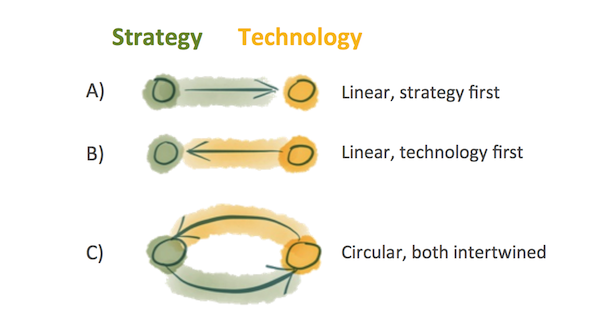6 implications for selecting and managing today's and tomorrow's marketing technology
We've been sharing the latest Marketing Technology Landscape map by Scott Brinker, @chiefmartec for several years now. You've almost certainly seen one of the earlier iterations since it has been widely shared. I love it because it's a USEFUL infographic - it prompts marketers to review their current Marketing Technology and take action to improve their Marketing Technology Stack.
When I discuss it with marketers when speaking or training, it certainly has a big impact, not always in a good way... It prompts that "OMG how do I cope?" fear amongst marketers and business owners due to its complexity. But, for me, from a positive POV, it shows the opportunity of the many tools we have available to deliver more relevant, more personalised communications today. It's inspired the Smart Insights team to create our own Martech infographic which includes both insight and operational tools across our RACE planning framework. We also have another post looking at auditing the Martech stack which includes another Scott Brinker framework - the 6C categories of Martech.
Our 'Essential Digital Marketing Tools' infographic aims to show the choice in martech today in a different way since it differs from Scott Brinker's awesome infographic in that it is:
- Simpler - fixed in size and structured around our RACE marketing management framework
- More practical - Blending tools which give marketing insight with marketing operations management tools
- Less corporate - it focuses recommendations of free, low-cost tools but also will include 'enterprise technologies'
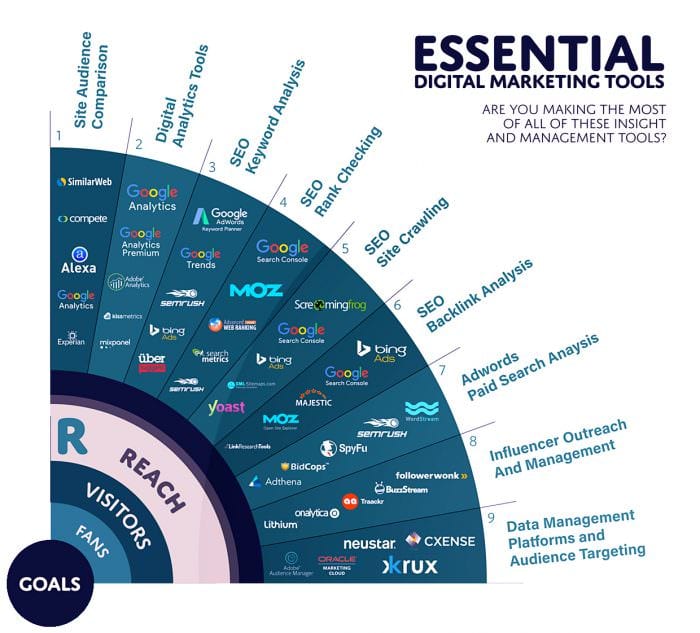
So, that's our tool, but you will be wanting to see the latest version from Scott, with 5000 different tools, DRUMROLL, here it is...
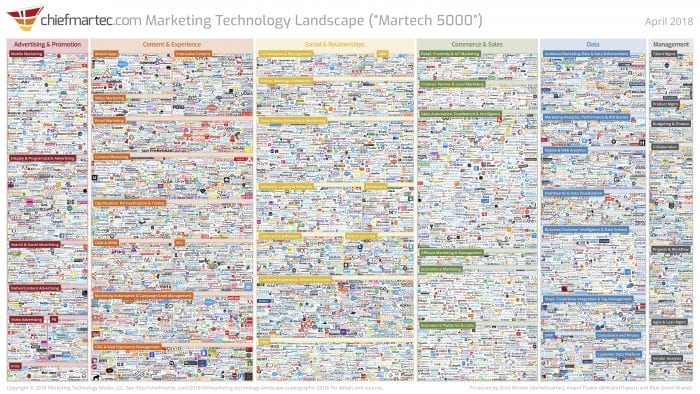
You can click on the graphic above to expand, as it is too large to be able to see individual logos.
If you want the hi-res 30Mb version, see Scott's post: Marketing Technology Landscape (2017).
It's great Scott to see the passion that Scott and collaborators have to update this each year given the speed at which technology changes. You can see the work involved from the number of new tools he has added each year:
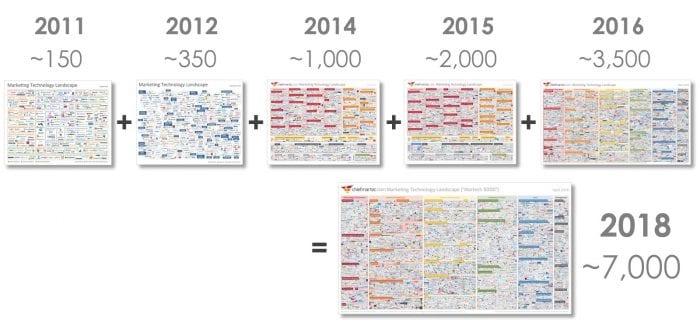
Implications from previous versions of the Marketing Technology landscape
Here, for comparison is the 2015 Marketing technology landscape infographic which we think provides a great framework to help managers think through the best technology to improve their marketing and to review the leading technology vendors in each category.
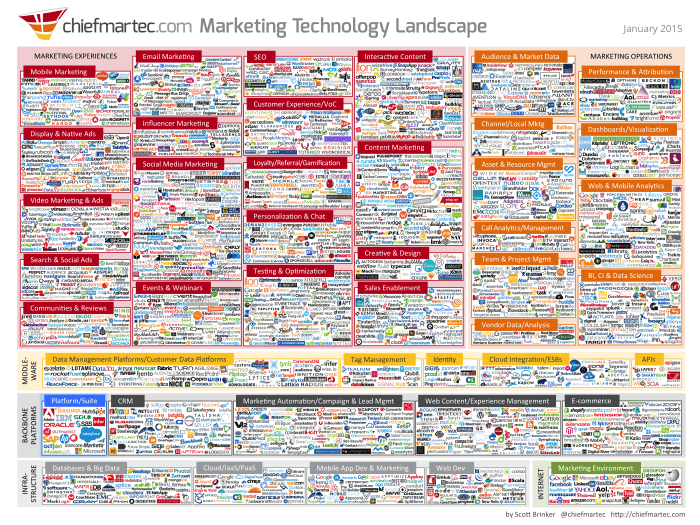
It’s a retina-burning infographic, which doesn’t look great on a blog or on a printer, but if you click to expand you can see its value and impact - it prompts you to ask "How do we make sense of this - what does it mean for us - what should we be using which we're not currently?!" There's good categorisation of all the tools too.
How do you find this? Is it scary to you because of the potential expense and business case preparation? Not to mention the challenges of managing implementation and integration of these systems. Or is it an opportunity to use technology to compete and create more relevant engaging customer experiences than your rivals.
The tool is useful in its own right, but I think it’s useful to prompt marketers to think about how they manage the complexity and range of options in technology which I explore in this post.
Categories of marketing technology
The first implication of this “infographic like no other” is that when you’re reviewing your approach to using technology, it’s useful to audit your technologies across these 6 categories and the 42 subcategories
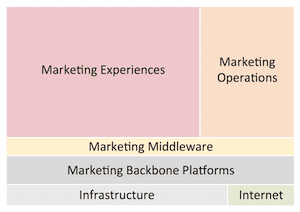
The six main categories to review are described like this by Scott:
- Marketing Experiences — more specialized technologies that directly affect prospects and customers across their lifecycle, such as advertising, email, social media, SEO, content marketing, A/B testing, marketing apps — the “front-office” of modern marketing.
- Marketing Operations — the tools and data for managing the “back-office” of marketing, such as analytics, MRM, DAM, and agile marketing management.
- Marketing Middleware such as DMPs, CDPs, tag management, cloud connectors, user management, and API services.
- Marketing Backbone Platforms such as CRM, marketing automation, content management, and e-commerce engines. [These are quite different in their application, so need to be reviewed separately].
- Infrastructure services such as databases, big data management, cloud computing, and software development tools.
- Internet services such as Facebook, Google, and Twitter that underlie today’s marketing environment. [How you integrate with these key platforms]
Selecting the best marketing technology
Beyond this, there are many other implications about how you select technology or make recommendations to your clients. The answers will vary a lot by type and size of company, but the implications are similar. Technology is a significant marketing investment, so it needs a structured, not piecemeal approach.
- 1. A solid business case and review approach is needed. Define a process and template for technology business case that avoids wastage and duplication and prioritises the technologies that will give the biggest returns. In larger companies this needs to be centralised to a great degree to avoid maverick purchases.
- 2. A technology roadmap is required as part of digital strategy. Starting from scratch, it would take years to implement these technologies. A technology roadmap helps prioritise and make it achievable.
- 3. All-in-one vs Best-of-breed solutions. One approach to reduce complexity is to use all-in-one solutions such as the Marketing Cloud services that many of the large technology companies like Oracle, Salesforce and Adobe are now offering. But these may be overkill for some businesses who may be best using simpler tools, for example, an email service provider rather than a full-blown marketing automation system.
- 4. Open source options can give significant savings. Open source can give significant savings in some areas such as content management or video hosting. But savings in licensing need to be offset against potential lack of support.
- 5. Businesses need to get the value from their technology investments. Implementing the technology is just the start. If a technology isn’t used by the business to get the value from it, then that’s bad management, not the fault of the technology or vendor.
- 6. Change management and education are as important as the technology. None of these technologies work without human intervention or intelligence. Customisation is needed, so encouraging ongoing adoption is key, although not all technology vendors support this as well.
Scott also has another post covering the implications for aligning technology and business strategy - showing how the two are intertwined (option c) rather than a top-down approach of business or marketing strategy and then find technology to support it (option a). So you need an element of both - Option b) shows that technology should impact strategy to help gain competitive advantage
